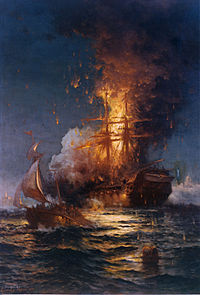American Slavery


Blacks debarking from the White Lion
It is commonly believed that the history of African Americans in English North America began in August 1619, when the White Lion, an English privateer based in the Netherlands, traded “20 and Odd Negroes” captured off Mexico from a Portuguese slave ship for food. Because these first blacks were Christians, probably from Angola, it is possible that they were initially treated as indentured servants, the system of cheap labor the English exported to their colonies.
However, he oldest city in North America, Florida’s St. Augustine, was founded by Spanish Admiral Pedro Menendez de Avilés on September 8, 1565. His expedition included soldiers, wives, and children, as well as Africans, most of whom were slaves. There had been previous Spanish expeditions to North America as early as Ponce de Leon’s exploratory voyages in 1515. The belief that the history of African Americans begins in 1619 is a perfect example how our Anglo-Saxon view of American history distorts reality.

During the 1600s, planters began to realize that permanent chattel (tangible personal property) slavery was far more profitable than hiring indentured servants, who were replaced at regular intervals when the period of their indentures was completed. Furthermore, if they ran away, as many indentured servants were wont to do, Africans could be easily identified. Slavery was hardly a new institution, but it took on new characteristics in the New World. Previously, slaves were mostly taken in battle. The fledging United States fought the Barbary Wars (1801 – 1805 and 1815) against Muslim pirates, who were capturing and ransoming American sailors and shipping. Thomas Jefferson refused to pay tribute and sent a fleet which bombarded fortified pirate cities in Libya, Tunisia, and Algeria – that’s why the Marine Corps anthem includes the lines “to the shores of Tripoli.”

The English word slave comes from “Slav,” reflecting the fact that many slaves in former times came from Slavic countries. In time, all Africans in Virginia came to be enslaved, although at first some Africans owned slaves themselves. Chattel slavery was a unique American experience. “Chattel” comes from the same root as “cattle.” Slaves were taxed as property just like oxen, horses, or pigs. Another uniquely American aspect was that slave families had no standing at all; slave families were frequently broken up to satisfy debts, or upon the death of their master to be distributed among his children.

Husbands, wives, and children were frequently sold off to planters in distant locations for a variety of other reasons. Some slave spouses lived “abroad” – at other plantations. Slave life in the cotton, sugar cane and rice field of the Deep South was generally much harder, with resultant shorter life expectancy.

American slavery was brutally enforced by whipping, mutilation, and mandatory slave patrols. A white man who killed a slave faced no consequences, and unless a master decided to “manumit” his slave, they remained a master’s property for life, or until a slave could purchase his freedom. Nonetheless, the South attempted to pass this off as a “benign” institution, insisting that most slaves were happy. This was belied by the number who ran away via the Underground Railroad before the war, and the hordes who left their plantations at the approach of Union forces once the Civil War started.
Slaves got one set of clothing a year and had shoes only in winter and their food was often the bare minimum required for subsistence. After the international slave trade became illegal in 1808, some masters “bred” slaves; every female slave was considered available to fill the carnal desires of their masters. Some slaveowners took “fancy girls,” or concubines. That’s why America has so many “Mullatoes,” individuals of mixed race. Thomas Jefferson had a concubine, Sally Hemmings, who was the step-sister of his deceased wife. Despite his oft-declared distaste for slavery, the only slaves Jefferson manumitted on his death were his and Sally’s four children, who were seven-eighths European!
